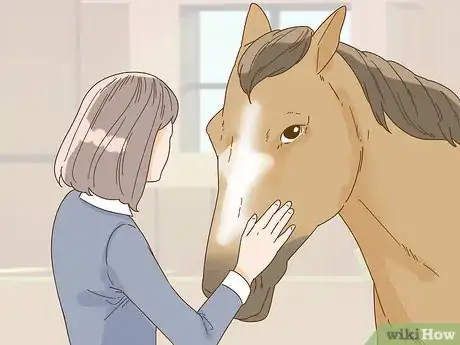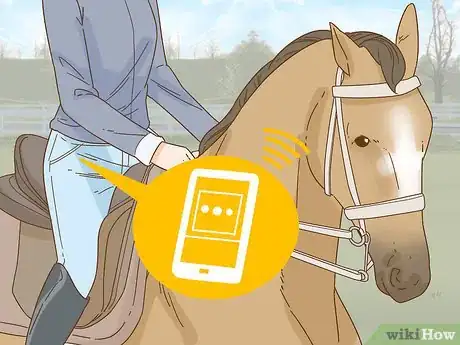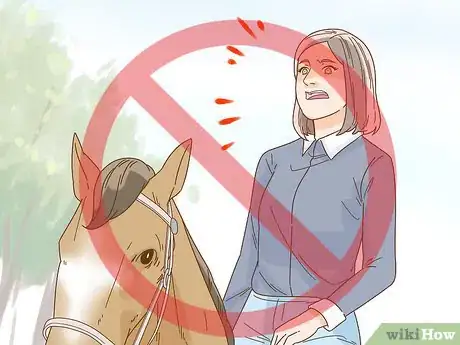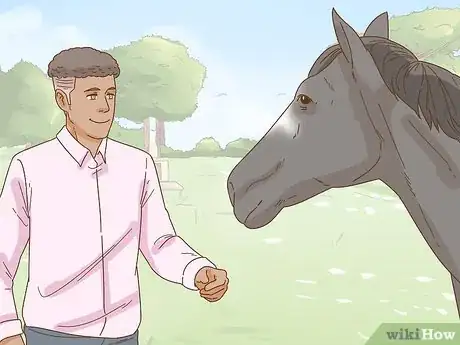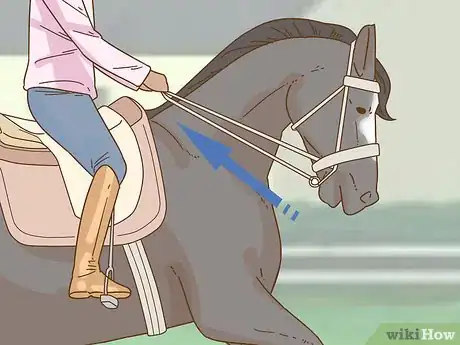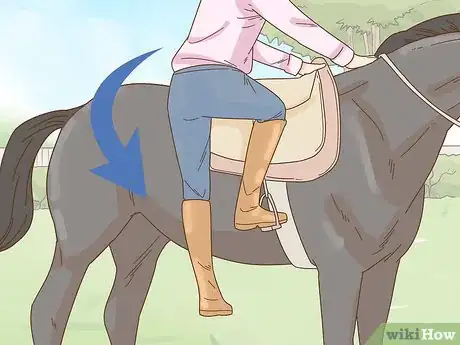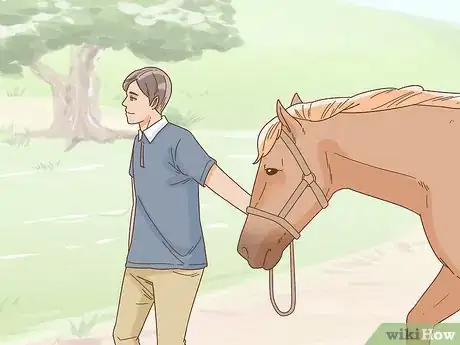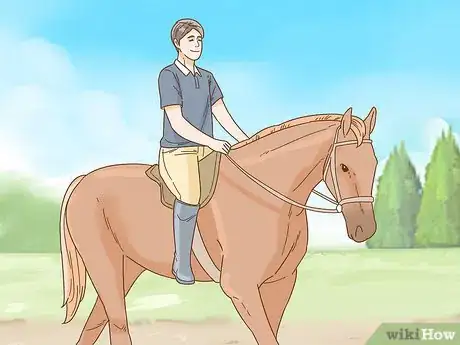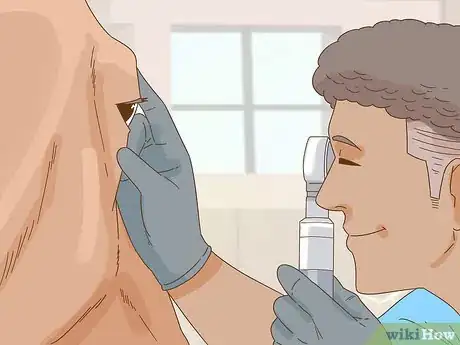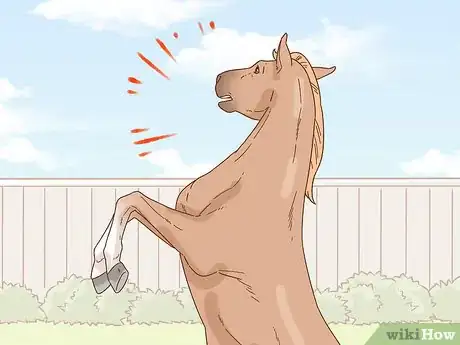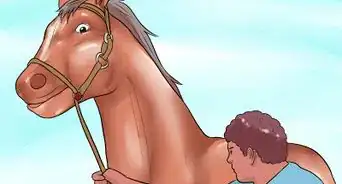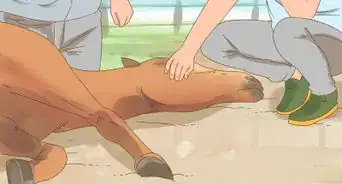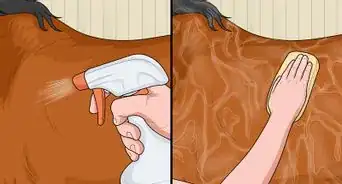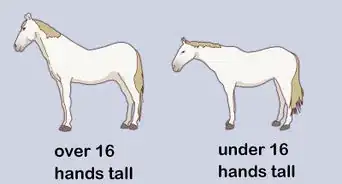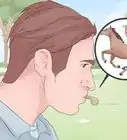This article was co-authored by Alana Silverman. Alana Silverman is a Certified EAGALA (Equine Assisted Growth and Learning Association) Equine Specialist and the Assistant Manager of Paddock Riding Club, a 200-horse premier equestrian facility based in Los Angeles, California. Alana has over 25 years of experience caring for and riding horses and specializes in English riding and riding instruction. She has a BA in Psychology from the University of Arizona.
wikiHow marks an article as reader-approved once it receives enough positive feedback. In this case, 100% of readers who voted found the article helpful, earning it our reader-approved status.
This article has been viewed 311,329 times.
A horse's emotions depend on her surroundings and the emotions of his or her human counterpart. Some horses have a tendency to be scared easily, or get "spooked." Sometimes spooking can occur simply because a horse comes into contact with an unfamiliar object, sometimes because of an alteration of its routine, and sometimes inexplicably.[1] If your horse gets spooked and you want to calm him or her down in a hurry, follow these steps.
Things You Should Know
- Stay relaxed while you're around the horse, and pet them before and during your ride to help them stay calm.
- Use a tempo application during your ride to help set a riding tempo for the horse. This app can be operated on your phone.
- Use a lateral flexion technique while riding, which forces the horse to slow down before stopping.
- To help the rider stay safe, point your horse toward the stressor and let them move sideways or backwards
Steps
Controlling Your Horse's Attention
-
1Get the horse's attention. Horses are generally only able to concentrate on one thing at a time, and the object on which they will likely focus when spooked is whatever has them spooked. If you can get the horse's attention away from this object, you will be better able to calm him or her quickly. You may even need to ride a horse in circles to get its attention off of whatever has it spooked.
- Horses can spook at pretty much anything, be it something in the environment, an unfamiliar object, or really anything.
- If the horse tenses up, flares its nostrils, widens its eyes, or points its ears back, it's frightened or stressed by something nearby.[5]
-
2Use lateral flexion. Lateral flexion is a neutral rein position in which you gently pull on one rein to turn the horse's head. This technique helps the horse slow down before stopping, which will help keep the horse from running when it gets spooked—in effect, lateral flexion can help distract the horse from it's own spooked reaction to a stressor. Lateral flexion is sometimes called a relaxation cue, hence its effectiveness in helping to quickly calm a horse.
- Lift the reins to feel the horse's mouth through them using one hand, then move your other hand down the rein. Reach until the arm is straight and touching the horse's mane.
- Place the opposite hand on the horse's neck firmly to keep yourself stable, and begin to close your fingers slowly from the pointer to the pinky, locking the pinky when you finish.
- The horse should now start to bend to the pressure of the rein, at which point you can begin to move your arm down to your thigh near your knee. The horse should bend at this point until there is slack in the rein and stop.
- If the horse doesn't stop at this point, push firmly with your stabilizing hand and wait. Release pressure when the feet have stopped.
-
3Continue to ride without acknowledgement of spooking. If the horse gets spooked, you can also try simply continuing your ride as though the horse had not been spooked at all. If you have tasks in mind, try to get the horse to focus on those as a distraction.[6]
- Tasks include training for jumping courses, dressage tests, and more.
-
4Point the horse toward the stressor. If you point the horse's nose at whatever is scaring it, but allow it to drift sideways or move backward, you will keep him or her from being able to run away in a panic because it would mean the horse would have to run toward the stressor. If the horse moves backward or sideways, you will direct its attention in a way that keeps the rider more safe. In order to keep from spooking the horse using this technique, be sure not to push him or her toward the stressor.
-
5Get off the horse. For your safety, first and foremost, you may need to get off the horse, and doing so can help put you in a better position to calm the animal. If you do get off the horse, one way to help calm him or her is to simply act as if nothing happened.
- It is not recommended to always get off your horse when it is spooked because it can be dangerous to abandon the animal. It can also train the horse that you will get off if it acts in a particular way, which is not what you want, so only get off under these circumstances if absolutely necessary.[7]
- You might also try to pet the horse on the withers as above to help calm it.
Expert Q&A
-
QuestionHow do you deal with a rearing horse?
 Alana SilvermanAlana Silverman is a Certified EAGALA (Equine Assisted Growth and Learning Association) Equine Specialist and the Assistant Manager of Paddock Riding Club, a 200-horse premier equestrian facility based in Los Angeles, California. Alana has over 25 years of experience caring for and riding horses and specializes in English riding and riding instruction. She has a BA in Psychology from the University of Arizona.
Alana SilvermanAlana Silverman is a Certified EAGALA (Equine Assisted Growth and Learning Association) Equine Specialist and the Assistant Manager of Paddock Riding Club, a 200-horse premier equestrian facility based in Los Angeles, California. Alana has over 25 years of experience caring for and riding horses and specializes in English riding and riding instruction. She has a BA in Psychology from the University of Arizona.
Certified EAGALA Equine Specialist Lean forward without screaming or yelling, keep your heels down, keep your torso long, and don't forget to breathe. You may be able to hold on to some horses' necks for stability, but don't rely on this for support.
Lean forward without screaming or yelling, keep your heels down, keep your torso long, and don't forget to breathe. You may be able to hold on to some horses' necks for stability, but don't rely on this for support.
Warnings
- You should never ride or be around horses with tennis shoes or any other casual shoes. You should always wear boots with a small heel, never flat bottoms.⧼thumbs_response⧽
- To avoid this problem, it is best to be with a horse who is good for your level of expertise. Green horses should never go with green riders. If you are a novice rider, it is best for you to be with older horses that are less likely to spook.⧼thumbs_response⧽
- Protective clothing should be worn when handling horses.⧼thumbs_response⧽
- If you have a jacket with a zipper, always have it zipped, many horses are afraid of a hanging zipper because it might rattle a little or reflect light.⧼thumbs_response⧽
References
- ↑ Jessica Rude. Equine Expert. Expert Interview. 18 September 2020.
- ↑ http://www.equisearch.com/discoverhorses/article/calm-rider-calm-horse
- ↑ http://animals.mom.me/calm-horse-startle-3664.html
- ↑ Alana Silverman. Certified EAGALA Equine Specialist. Expert Interview. 17 March 2020.
- ↑ Jessica Rude. Equine Expert. Expert Interview. 18 September 2020.
- ↑ http://animals.mom.me/calm-horse-startle-3664.html
- ↑ http://www.thinklikeahorse.org/horse_fear.html
- ↑ http://www.aspca.org/pet-care/virtual-pet-behaviorist/horse-behavior/spooking-under-saddle
- ↑ http://www.aspca.org/pet-care/virtual-pet-behaviorist/horse-behavior/spooking-under-saddle
About This Article
To quickly calm your horse down, try to distract it and get it to focus on something else so it forgets about whatever spooked it. You can also gently pull on one of its reins to turn its head, which will distract it and slow it down so it doesn't run. Whatever you do, try not to show fear or stress since it will only stress out your horse even more. Also, if necessary, get off of your horse for your own safety, and try to act as if nothing happened. For more tips from our Veterinarian co-author, like how to prevent a horse from getting stressed in the first place, read on!


